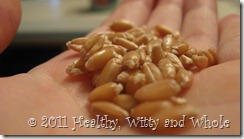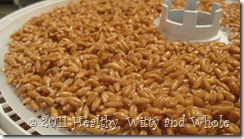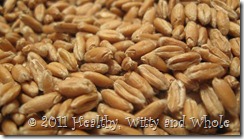I’m posting this to participate in GNOWFGLINS Simple Lives Thursday! :-)
How to Sprout Grain for Bread and Baking:
Several years ago, when I was around 17 or 18, I first attempted sprouting grain and making bread from it. A bread-baking veteran of 8 years, I knew bread making quite well, but sprouted grain was beyond me at the time and I gave it up. Last year, I started trying again. This time, I used our 2 dehydrators (we owned one and then someone gave us another one) and mesh sheets to dehydrate the grain instead of the oven. I bought some grain from To Your Health Sprouted Grain to compare with mine. I now have conquered the tricks of sprouted flour and now I am attempting a new challenge, sprouted sourdough bread. We’ll see how it turns out. I made my own sourdough starter, and so far, so good. :-)
Sprouting the grain is a some of a hassle, but well worth it. I sprout hard red wheat and it makes the softest, flavor rich loaves. Unsprouted, red wheat is dense and make small, unsavory loaves. I’m happy that it makes such a difference to sprout, since red wheat is so much more nutritious than white.
To sprout, I soak my grain in water for 12 hours. This helps gets rid of all the bacteria and enzyme inhibitors in the grain. After soaking, I drain the water and let it sprout all night. The sprouts should be barely visible, at the most an 1/8 of an inch, no more or else your bread will flop. That’s teary-eyed experience speaking. ;-)
Then, I spread the grain on my dehydrator racks that have mesh screens on them and dehydrate at least 12 hours, sometimes more like 18. The grain has to be very dry. That’s very important. I ruined a grain mill once. *ahem* *blush* Grind like normal whole grain and use for any recipe asking for flour. Because it has a little bit more moister than other flour, you will have to use a little more than you use for whole wheat flour, but about equal amounts with white flour.
Benefits of Sprouted Grain:
Why is sprouting grain so good for you? For the answer, I’ll go to the “professionals”, those who can say it much more eloquently than I could ever try to.
Kelly the Kitchen Kop says that:
“Sprouting radically changes grains by:
- Changing the composition of starch molecules, converting them into vegetable sugars, so the body recognizes and digests sprouted grains as a vegetable.
- Enzymes are created that aid digestion, complex sugars are broken down which can eliminate painful gas, and vitamin and mineral levels increase.
- Sprouting neutralizes potent carcinogens and enzyme inhibitors, as well as an acid that inhibits absorption of calcium, magnesium, iron, copper and zinc.”
Nourished Kitchen blog says: “When examining the nutrient density of sprouted wheat to unsprouted wheat on a calorie-per-calorie basis, you’ll find that sprouted wheat contains four times the amount of niacin and nearly twice the amount of vitamin B6 and folate as unsprouted wheat; moreover, it contains more protein and fewer starches than non-sprouted grain and as a further boon, it is lower on the glycemic index making it more suitable for those suffering from blood sugar issues.”
There is lots of information from To Your Health Sprouted Flour and Summers Sprouted Flour Company, which are good places to buy sprouted grain/flour if you can’t do it yourself. I’ve also heard a lot of research saying that those who are gluten-intolerant can eat sprouted flour products because of the enzymes being activated.








Hi. I love hearing about peoples mistakes and proper explanations. Thank you soo much. I bought some heritage red fife wheat and have been wanting to try sprouting but of course very unsure of the whole procedure. Someone else on another blog explained in great detail how to make a good loaf of whole wheat bread, including her mistakes and tips… I have finally made many consistant loaves of awesome bread. So now that I have that mastered I’m reading to try sprouting. But…. I do not have a mill. Could I use a blender or food prosessor for small daily batches? Also after the wheat is dryed can you store in the freezer till ready to grind? Or grind it and then freeze it?
Thank you :)
Thanks for your comment! I’m sure that would work. If you have a good quality blender (such as a Vitamix), then doing it in small batches would probably work. Some people who don’t have grinders actually grind it just after sprouting with it still wet and then make the bread with the wet grain. I’ve never experimented with that though. If you don’t have a good quality blender, then you might consider soaking your flour. It does the same thing that sprouting grain does. I can email you more about that if you like. I plan to post a tutorial on that eventually. Thanks for visiting my blog! Let me know if you have any more questions.
I’m so glad to find this post! I soak, dry, and grind my hard red wheat grains for breadmaking. But, the flour comes out gritty, like sand, and makes my loaves flop–if they rise in the first place. I follow the exact same procedure you do; the only thing I’d like to know is, What temp do you dry your grains on in the dehydrator? I have an old model Excalibur and I’ve tried drying them on various temps, but the same results. The last time I dried grains (yesterday) I dried them on 135 degrees for about 10 hrs or so. The flour comes out the same. (I haven’t made bread from that last batch yet.) Should I dry them on a lower temp for a longer period? Or a higher temp for a shorter period? Or…. Help, please!
Hi! Thanks for the comment! Sprouting grain is challenging…I’ll give ya that. It was quite a learning curve for me. I dry my wheat at 145 for at least 12 hours. I really don’t think the drying is the problem. If it wasn’t getting it dry, your flour wouldn’t be gritty. I’m trying to think what would make the flour gritty, I’ve not necessarily had that problem before. I’m trying to think of some different solutions here for you.
1. Is your flour gritty when you grind without sprouting it? It may be that your grain is old. I’m not sure if that is even a liable solution, just thought I’d throw it out there. :)
2. Are you grinding it very fine? My grinder has several levels and I try to get it as finely ground as possible. I don’t know if that is even an option on your grinder though.
3. How big of sprouts do you let grow? I only let mine barely sprout. I’ve noticed if I accidentally let mine get too long, then my bread flops and I only can use my flour for quick breads that don’t need to rise as much.
Let me know if this helps at all. I’m still trying to think of some different ideas here. :)